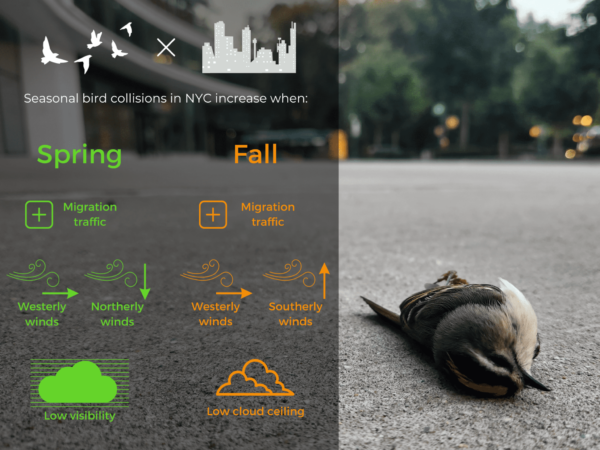
Helping Stop Bird Collisions with City Buildings
Window collisions are the third-greatest human-related source of bird mortality on earth, behind only habitat loss and predation by domestic cats. More than 1 billion birds are killed by collisions with glass every year in the U.S. and Canada alone. Many collisions occur in cities, where light pollution attracts dense concentrations of migrating birds into a confusing maze of buildings covered in glass. As awareness of this issue has rapidly grown in recent years, there is new urgency to understand the risk factors underlying collisions so practical, science-based solutions can be identified.
To that end, Great Hollow’s executive director and ornithologist, Dr. Chad Seewagen, teamed up with researchers from Columbia University, Cornell University, and New York City Audubon to identify the conditions under which birds are at greatest risk of colliding with windows in Manhattan during spring and fall migration. Led by Columbia graduate student, Katherine Chen, the team used NEXRAD radar to detect and count the number of birds migrating over the city at night and then examined correlations of nightly migration intensity and weather conditions with the number of dead birds counted by citizen scientists on standardized survey routes along city sidewalks. The effort involved dozens of volunteers, five years of surveying, and two years of data analysis and interpretation, making it the first collision study of this scale. The findings, published today in the Journal of Applied Ecology, show that northerly and westerly winds, low visibility, and high migration traffic rates lead to increased collisions during the spring, and southerly and westerly winds, low cloud ceiling height, and high migration traffic rates lead to increased collisions during the fall. Low visibility alone was associated with a three-fold increase in springtime collisions. When migrating birds encounter these inclement weather conditions over the city, they are more likely to terminate their flight and descend into the city’s greenspaces to rest, which, in turn, increases the potential for collisions with windows during their layover.
“Lights Out” campaigns, which encourage city building managers to reduce outdoor lighting during migration, are one of the most effective tools for decreasing bird collisions by reducing the attraction of migrating birds to urban areas in the first place, but it is unrealistic to expect lights to be turned off throughout the entire spring and fall. The results of this study, combined with weather forecasts and models developed by Cornell to predict nightly migration intensity, will allow Lights Out efforts to instead focus only on the subset of nights in the migratory period that are predicted to have relatively high collision risk. This targeted approach will make building managers more likely to participate in Lights Out campaigns since it will require them to reduce light emissions only for days instead of weeks or months each migration season. If you would like to make the windows on your home bird-friendly, we recommend visiting BirdSavers.com for an inexpensive, effective way of reducing collisions.
Reference: Chen, K., S.M. Kross, K. Parkins, C.L. Seewagen, A. Farnsworth, and B.M. Van Doren. 2024. Heavy migration traffic and bad weather are a dangerous combination: bird collisions in New York City. Journal of Applied Ecology, doi.org/10.1111/1365-2664.14590.

 Previous Post
Previous Post Next Post
Next Post